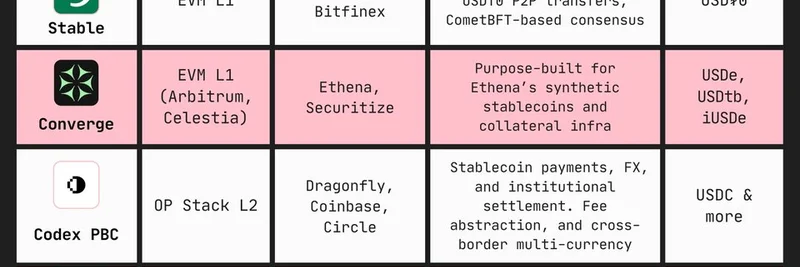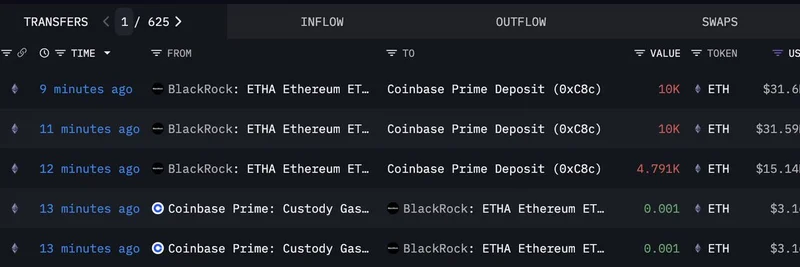Move over, Layer 2 battles—the real action is heating up in the world of stablecoin chains. If you've been following the crypto space, you know stablecoins like USDT and USDC are the workhorses of blockchain payments, pegged to the dollar for stability. But now, major players are launching dedicated blockchains optimized just for these digital dollars, aiming to handle millions of transactions with ultra-low costs and built-in features for real-world use. This shift could supercharge everything from remittances to institutional finance, and it's all unpacked in a recent thread from Pink Brains on X.
The thread kicks off with a handy comparison chart of the top contenders, highlighting their blockchain types, backers, key features, and native stablecoins. It's a snapshot of how companies like Tether, Circle, and even Stripe are betting big on custom chains to dominate the stablecoin payment game.
Why Stablecoin Chains Are the Next Big Thing
General-purpose blockchains like Ethereum or Solana are great, but they weren't built for the demands of stablecoin-heavy traffic. We're talking about needing millisecond-fast transactions, predictable fees paid in the stablecoin itself, easy fiat on-ramps (ways to convert traditional money to crypto), and privacy that meets regulatory standards. These new chains are "vertical" solutions—specialized from the ground up for payments and settlement, making them ideal for scaling stablecoins globally.
As the thread points out, this isn't about reinventing the wheel; it's about creating smoother, more efficient rails for money movement. Let's break down the key players mentioned, with simple explanations of the tech terms to keep things accessible.
Plasma: Bitcoin-Secured Speed for USDT
Leading the pack is Plasma, an EVM-compatible (meaning it works like Ethereum for smart contracts) sidechain backed by Bitcoin's security. Developed with support from Bitfinex and Founders Fund, it uses PlasmaBFT—a tweaked consensus mechanism for quicker finality and high throughput (how many transactions it can handle per second).
Key perks include zero-fee USDT transfers, customizable gas tokens (fees for network use), and optional confidential payments. It even has a trust-minimized bridge for moving Bitcoin directly into the EVM world. Plasma's already partnering with projects like YellowCard for African remittances and Curve Finance for efficient stablecoin swaps. With $24M raised and a testnet live, mainnet launch is imminent—watch for this one to bridge crypto and real-world finance seamlessly.
Stable: Tether's High-Throughput Powerhouse
From the folks at Bitfinex and Tether comes Stable, another EVM Layer 1 chain running on StableBFT for low-latency operations. It aims for up to 10,000 transactions per second (TPS) with optimistic parallel execution (processing multiple things at once to speed things up).
USDT0 is the star here, with gas-free peer-to-peer transfers and account abstraction (simplifying user interactions so you don't need to worry about gas). Future plans include fiat ramps and debit card integration for a Web2-like experience. After raising $28M in seed funding, it's in private testnet now, with public access on the horizon.
Converge: Ethena's Institutional-Focused L2
Built on Arbitrum tech with Celestia for data availability (storing info off-chain to keep costs down), Converge is an Ethereum Layer 2 co-developed by Ethena Labs and Securitize. It uses USDe and USDtb for gas, with a custom sequencer targeting 100ms block times (super fast confirmations).
Staking ENA tokens secures the network, and it's geared toward institutions with custodial partners like Fireblocks. Big names like Hamilton Lane are bringing tokenized assets, while DeFi protocols such as Pendle and Aave are integrating for yield opportunities. This chain is all about blending synthetic stablecoins with real-world collateral for pro-level finance.
Codex: OP Stack for Reliable Settlements
Codex is an Ethereum L2 using the Optimism (OP) Stack, hosted by Conduit for high throughput. It's tailored for stablecoin payments with features like deterministic execution (predictable outcomes for reliability) and built-in FX (foreign exchange) primitives for multi-currency deals.
Backed by $15.8M from Dragonfly, Coinbase, and Circle, Codex launched its mainnet in mid-2024. It's perfect for businesses needing compliance and privacy in workflows like payroll or trade settlements—think stablecoins meeting enterprise standards.
Noble: Cosmos Meets EVM for Interoperability
Starting as a Cosmos chain for issuing USDC via IBC (Inter-Blockchain Communication), Noble has handled over $8B in volume. Now, it's expanding with the Noble AppLayer, an EVM rollup secured by Celestia for 100ms blocks and composable yields on its USDN stablecoin.
This setup bridges Cosmos and EVM worlds with tools like Hyperlane for cross-chain liquidity. After a $15M Series A led by Paradigm, the AppLayer is slated for a summer launch, making Noble a versatile player for stablecoin flows across ecosystems.
Arc: Circle's Enterprise Settlement Engine
Circle's Arc is a high-performance chain boasting 3,000 TPS and sub-350ms finality. USDC handles gas, with support for interest-bearing USYC and an on-chain FX engine for swaps.
It includes opt-in privacy, MEV protection (to prevent front-running trades), and tight integration with Circle's tools like CCTP (Cross-Chain Transfer Protocol) for seamless bridging. Private testnet is rolling out soon, aimed at fintechs and institutions embedding tokenized dollars into everyday operations.
Tempo: Stripe's Payment-Focused Blockchain
Details are scant, but Tempo—backed by Stripe and Paradigm—is an Ethereum-compatible chain with no volatile native token, just stablecoins for fees. It integrates Stripe's merchant network, using acquisitions like Bridge for infra and Privy for easy wallets.
Led by Paradigm's Matt Huang, Tempo is about invisible crypto rails for global payments, blending Stripe's compliance with blockchain speed.
The Bigger Picture for Stablecoin Dominance
These chains share common threads: stablecoin gas fees, blazing-fast TPS, free transfers, fiat integrations, and a focus on practical finance over hype. As the thread wraps up, multiple winners could emerge, each tied to issuers like Tether or Circle, but all chasing the same goal—a frictionless way to move money worldwide.
For meme token enthusiasts, this matters too: stablecoin chains could provide the stable rails needed for high-volume trading of volatile assets like memes, with lower fees and faster settlements boosting liquidity across the board. Keep an eye on these developments; they're reshaping the blockchain landscape one stable transaction at a time.
If you're diving into DeFi or payments, check out Pink Brains' original thread for more insights, and stay tuned to Meme Insider for how these trends intersect with the wild world of meme coins.



